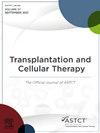Bloodstream Infections and Colonization in Hematopoietic Stem Cell Transplant Recipients at a South African Center: A Retrospective Analysis
IF 3.6
3区 医学
Q2 HEMATOLOGY
引用次数: 0
Abstract
Bacterial bloodstream infections (BSIs) are a serious complication after hematopoietic stem cell transplantation (HSCT), especially when caused by multidrug-resistant (MDR) bacteria. However, data on BSIs post-HSCT from centers in sub-Saharan Africa are limited. This study aims to describe the incidence, etiology, and outcomes of BSIs, including those caused by carbapenem-resistant Enterobacterales (CRE), in both autologous and allogenic HSCT recipients in South Africa. Furthermore, this study examines the incidence and clinical impact of colonization with CRE. A retrospective analysis was performed on clinical data from HSCT recipients, transplanted between January 2018 and December 2023 at Groote Schuur Hospital (GSH) and Red Cross War Memorial Children's Hospital, the academic hospitals of the University of Cape Town. Data were extracted from the transplant unit electronic and paper patient records, Hematology Patient Registry, and the National Health Laboratory Service electronic database. Surveillance cultures were taken upon admission and subsequently repeated weekly for GSH patients. In total, 270 HSCT recipients were included: 145 underwent autologous HSCT, and 124 an allogenic HSCT. The most common indication for autologous HSCT was multiple myeloma (52%), while acute myeloid leukemia was the most frequent for allogenic HSCT (34%). The overall incidence of BSIs was 35%, with a higher rate observed in allogeneic HSCT recipients (48%) compared to autologous HSCT recipients (23%). Gram-negative bacteria were the most common pathogens, and CRE were responsible for 9% of BSIs. Carbapenem-resistant Klebsiella pneumonia spp. was the most common CRE found in BSI and rectal surveillance cultures. Surveillance cultures with CRE were detected in 19% of the HSCT recipients during admission to the transplant unit, with oxacillinase-48 (and variants) the most prevalent carbapenemase. Colonization by CRE was an independent risk factor for developing BSIs. Within 100 days post-HSCT, 25 HSCT recipients (9%) died, of whom nine (36%) had a BSI in the last 7 days of life. Bivariate analysis revealed that BSIs significantly reduced overall survival in both autologous and allogenic HSCT recipients, with a further decrease in survival when the BSI was caused by MDR bacteria. BSIs are a frequent and severe complication among HSCT recipients in South Africa, particularly in those receiving allogenic HSCT. Colonization with CRE significantly increases the risk of BSIs, underscoring the need for vigilant infection control and targeted antimicrobial strategies in this vulnerable population.
南非某中心造血干细胞移植受者的血流感染和定植:回顾性分析。
背景:细菌性血流感染(bsi)是造血干细胞移植(HSCT)后的严重并发症,尤其是当多药耐药(MDR)细菌引起时。然而,来自撒哈拉以南非洲中心的hsct后bsi数据有限。目的:本研究旨在描述南非自体和同种异体造血干细胞移植受者bsi的发病率、病因和结果,包括碳青霉烯耐药肠杆菌(CRE)引起的bsi。此外,本研究还研究了CRE定植的发病率和临床影响。研究设计:对2018年1月至2023年12月在开普敦大学附属医院grote Schuur医院(GSH)和红十字战争纪念儿童医院(RCWMCH)移植的HSCT受者的临床数据进行回顾性分析。数据提取自移植单位的电子和纸质患者记录、血液学患者登记和国家卫生实验室服务电子数据库。入院时进行监测培养,随后对谷胱甘肽患者每周重复一次。结果:共纳入270例HSCT受者:145例接受自体HSCT, 124例接受同种异体HSCT。自体HSCT最常见的适应症是多发性骨髓瘤(52%),而同种异体HSCT最常见的适应症是急性髓性白血病(AML)(34%)。bsi的总发生率为35%,异体造血干细胞移植受者(48%)的发生率高于自体造血干细胞移植受者(23%)。革兰氏阴性菌(GNB)是最常见的病原体,CRE占bsi的9%。耐碳青霉烯肺炎克雷伯菌是BSI和直肠监测培养中最常见的CRE。在进入移植病房时,19%的HSCT受者检测到CRE的监测培养,其中OXA-48(及其变体)是最常见的碳青霉烯酶。CRE定殖是发生bsi的独立危险因素。移植后100天内,25名移植受者(9%)死亡,其中9名(36%)在生命的最后7天内出现BSI。双变量分析显示,BSI显著降低了自体和同种异体HSCT受者的总生存率,当BSI是由耐多药细菌引起时,生存率进一步降低。结论:bsi是南非移植患者中常见且严重的并发症,特别是在接受同种异体移植的患者中。CRE定殖显著增加了bsi的风险,强调了在这一脆弱人群中警惕感染控制和有针对性的抗菌策略的必要性。
本文章由计算机程序翻译,如有差异,请以英文原文为准。
求助全文
约1分钟内获得全文
求助全文
来源期刊

Transplantation and Cellular Therapy
Medicine-Hematology
CiteScore
7.00
自引率
15.60%
发文量
1061
审稿时长
51 days
 求助内容:
求助内容: 应助结果提醒方式:
应助结果提醒方式:


